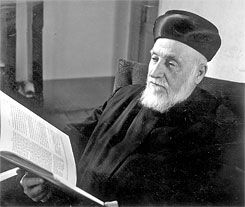A Short Tribute
Hacham Yaakov Moshe Toledano was born to Miriam-Remo and Hacham Yehuda Toledano in 1879, in Tiberias, where his father, who had immigrated to the Land of Israel in 1862 from Meknes, Morocco, headed a yeshiva. He began his studies with Rabbi Chai Elyakim, and continued them in his father's yeshiva.
In 1896, at the age of 17, he married Mas'ouda Hannah, Moshe Aharon Shlush's daughter. He was ordained to the rabbinate that same year, and began teaching at his father's yeshiva.
In 1914, with the outbreak of the First World War, his family was expelled to Corsica by the Turks, along with 800 residents of the Galilee, because of their French nationality. Hacham Yaakov Moshe Toledano served there as rabbi, but returned to Tiberias immediately at the end of the war, where he worked towards the reorganization of the Sephardi community and its institutions. His efforts brought about the founding of the Beit Mikra La'Am cultural center, where current newspapers could be read, but within a year the center closed because of opposition from zealous individuals in Tiberias.
Hacham Yaakov Moshe Toledano worked on the restoration of the holy sites located in the city's surroundings. He tried involving the Hovevei Zion Society and the Jewish National Fund in redeeming the land surrounding the tombs of Maimonides and Rabbi Akiva, but did not succeed in raising their interest. Instead, he founded the Maimona Society that purchased a large plot of land from the Arabs, on which the first neighborhood in the outskirts of Tiberias was built.
Hacham Yaakov Moshe Toledano collected and studied ancient manuscripts, principally from Spain and North Africa, dating as far back as the period of the Geonim (589 – 1038 C.E.). His most important discovery in this domain was Maimonides' commentary on the Mishna in the original Arabic.
In 1926, he responded to an invitation to serve as dayan in Tangiers, where he devoted himself to culture, instilling in the Tangiers community a love for the Hebrew language, the Land of Israel and its settlement. He also founded the Torah Ve'Haim study house for rabbis and teachers in Tangiers.
In 1928, he was appointed Av Beit Din (President of the Rabbinic Court) and Deputy Chief Rabbi of Cairo. In 1933 he was appointed to the same position in Alexandria, where he subsequently also held the role of Deputy Chief Rabbi.
He was appointed Chief Rabbi of Tel Aviv – Yaffo in 1942. At the end of the Second World War, following the Holocaust, he established a special rabbinic court for agunot (married women whose husbands have left or disappeared without granting them a divorce). He was appointed Minister of Religious Affairs in 1958, and held the position until his death.
Hacham Yaakov Moshe Toledano authored books on religion, research and Responsa. He was also involved in the publication of historic texts. His published work includes Yam HaGadol – Responsa, Meshiv HaNefesh, Sarid U'Palit, Bat Ami - on the issue of Agunot after the Holocaust, and Tiberias and its Surroundings – a collection of articles.
Hacham Yaakov Moshe Toledano passed away on 24 Tishrei 5720 (1960) and was buried in the Har HaMenuhot cemetery in Jerusalem.
